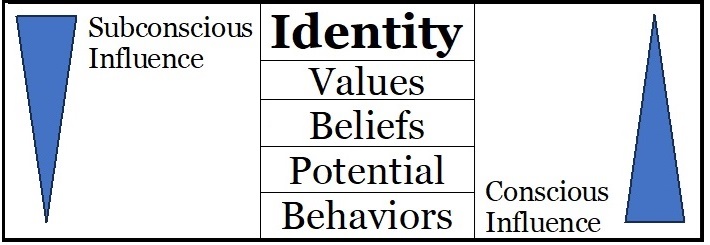Mind Layers: Identity

Now we come to what many people believe is the pinnacle of human personality, namely the identity. As we've already seen with values and some beliefs, the identity is based in the subconscious.
There are three critical things to know about the identity layer:
- The first is that we actually all have multiple identities. We're not talking about multiple personalities; that's a completely different phenomenon. Instead, any given person has numerous life experiences, many of which can shape his or her overall identity. The earlier the experience, the more impact that experience will have.
- Furthermore, most people assume that our identities never change. It turns out, many aspects of our identities change throughout our lives. Some of that change is very natural and we don't even think of it. Other facets can change either due to life experiences/circumstances, or if we decide we want to change them.
- Finally, our identities are at the top of our personality hierarchy. What exactly does that mean? In short, when some aspect of our identities change, that creates a cascade effect throughout our values, beliefs, potential and behaviors. When a person wants to make a change in his or her life, one of the most effective ways to do so is to make changes to the identity. Then that one change will cascade down through the rest of the layers.
How The Identity Surfaces
Identities, like values, reside in the subconscious. In fact identities are buried very deeply in the subconscious, and most people don't spend much time considering what identities they have. But those identities show themselves indirectly.
Specifically, any statements starting with "I am <some characteristic>" is a solid indicator of a person's identity. Examples would be "I am tall", "I am a college graduate", "I am stupid", "I am overweight", "I am a coward", etc. This is when an identity is broadcasting itself.
When an identity is beneficial in some way, a person will be proud of that identity and boast about it. For instance, "I am a college graduate", or "I am a CEO", or "I am a new mom" are all statements about a person's identity. Even when a person is not proud of it, they'll still talk about it in those terms. Sometimes they'll use it as a reason why they can't do something. Examples: "I'm stupid, so I can't do well in school," or "I'm overweight so no, I don't participate in sports" or "I'm broke, so I can't afford to do that." Even when a person wants to do something, that identity will get in the way. Also notice that the identity ("I am or I am not") is used to justify the potential ("I can", "I do", "I cannot" or "I don't"). This is another example of the hierarchy amongst the mental layers.
Sometimes a person will have an old identity that they're proud of, and a new identity that they are not pleased with. That combination will express itself as "I used to be an athlete, but now I'm overweight" or "I used to be an executive, but now I'm a door-greeter." These are powerful statements, not only about how identities change, but also about how people can prioritize who they were, and regret who they have become. That is actually something we can use to help them accomplish that change. That comparison proves that identities can and do change.
When getting started with the process of changing a facet of identity, particularly when we are really discouraged, it helps to remind ourselves of other shifts we've made from a prior identity to a new, better identity. That opens the door to the possibility of improvement with other identity facets. Then, we can more easily move forward with the changes we want to make. This can be powerful assistance when our current situation seems insurmountable, and/or when we don't see any other options. Just reminding ourselves that yes we've changed other aspects of our identities in the past, can be enough to shake loose some options in the present.
How the Identity Shapes Our Lives
Recall from our conversation about brain waves and mental states, that our earliest childhood years are characterized by the alpha mental state. Also recall that this state is that unique place where both the conscious and subconscious levels of the mind are accessible. This means that, for the first five or so years of life, we are absorbing information into the subconscious, even though we're fully awake at the time. And that transfer of information occurs at an astounding rate. Ask any parent and they'll tell you that their children will be able to quote them almost exactly, even weeks or months later, usually from events that the parent doesn't remember. We're literally "information sponges" during adolescence.
So when a child is in the presence of someone with a certain identity, the child will absorb every aspect of that role model's values, beliefs, potential and behavior, and associate it with that identity. As soon as the child is in someone else's presence, the process repeats with that next role model, and so on. The people that a child spends the most time with have the most profound impact upon that child, even if those people are not blood relatives. That being said, highly emotional moments with another individual will have an outside impact upon a child's perception of various adult identities.
The role model is usually not aware of that kind of impact, and may exhibit either beneficial or damaging characteristics in front of the child, expecting the child to be able to discern the difference. Particularly when adults are behaving poorly, they often brush off the chances of that behavior impacting a child's understanding of that conduct. In short, the adult assumes the child should "know better". Unfortunately, children don't start "reasoning" out behaviors until they are at least 6 years old. Instead, children absorb all of it on a subconscious level, without judgement or evaluation, and then emulate it from that point forward as "normal" conduct.
How Identity Can Create Problems
If we are at a point in life that we're happy with, most of the facets of that identity will be constructive and healthy. That identity will give us room to continue building and improving new, better identities. However, even well-adjusted individuals usually have at least one aspect of their identity that they don't like. Perhaps it's being over- or under-weight. Perhaps it is being in excessive debt. Perhaps it is imposter syndrome, procrastination, lack of motivation, or some other element. That single facet of the identity can make an oversized impact on a person's feelings of self-worth.
If left untended, these undesirable (and sometimes downright toxic) elements of the personality can not only impact a person's self-image, they can interfere with a person's ability to accomplish goals. They can even threaten a person's health. For instance, a person who smokes, drinks excessivly or frequently uses drugs will start off saying that these are activities they do. But after a few years they'll describe themselves in those terms, ie "I'm a smoker", or "I'm an alcoholic", or "I'm a druggie". This is when an activity has become part of the identity. Thankfully, we have methods for addressing dysfunctional identity elements of the identity, and either changing them or replacing them with healthier alternatives.
Change The Identity, Change Our Lives
One of the most common strategies people use to make changes in their lives, is to make changes to their environment. In other words, they move, they spend time in different places, they quit one job and start another, or otherwise shift their exterior situation. Sadly, that's the least effective way to make changes that really "stick". The most effective approach is to make changes at the Identity level. While that may sound difficult, NLP, hypnotherapy and coaching all have techniques for accomplishing that. When a coach combines those approaches, it can result in profound change.
Sometimes we realize we have some aspect of our personality that isn't working well for us. Call it a coping mechanism, call it a weakness, call it a scar from past experiences, call it whatever seems to fit. As you read through the various layers of the mind, you might see where this or that issue seems to reside. Changing it at that level may create the change you want. However, sometimes that element of our personality actually comes to us thanks to our identity. If we make changes at the Identity level, we'll successfully get to the core of the issue, and any changes we make will actually be much more effective and long lasting.
As with other levels, we can learn to change them for ourselves by taking classes in either self-hypnosis and/or NLP techniques. If you're interested in exploring such classes, check out the Transform Destiny website for a comprehensive list of online classes. A great place to start is Empowering Yourself For A Change. You can work through them at a pace and schedule that works best for you.
If that seems a bit intimidating, or you'd rather just get to the bottom of the problem by working with a certified coach or NLP practitioner, contact me and we can talk about how best to serve your needs.
|
Shopping Cart |
|
Contact Me For Help Reaching Your Goals

When you're ready to move forward, push through obstacles and make real progress towards your goals, Contact Me today.
New Products and Services Request Form
Do you have a product or service request that you don't already see listed here? I'd love to hear your ideas! Please feel free to either Contact Me or fill out my new Product and Service Request Form.
Thanks for your suggestions!
